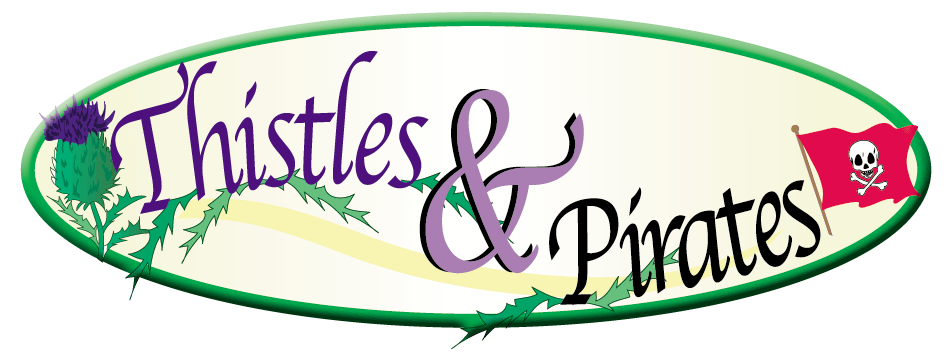| Cindy
Vallar
Author,
Editor, & Pirate Chronicler |
 |
| Cindy
Vallar
Author,
Editor, & Pirate Chronicler |
 |
Over a decade ago, I started to write a novel set in Scotland, but didn’t know much about the country’s history. Since then, I read many books on various aspects of Scotland with particular emphasis on the events of the Rising of 1745. I also visited Scotland three times, the last in August 2001 to attend the international gathering of Clan Cameron at Achnacarry, the estate of the Cameron chief, Sir Donald Cameron of Lochiel.
Space limitations prohibit me from writing a detailed summary on the history, clans, and culture of Scotland. What follows is a general overview with a listing of websites where you will find more information. If you seek books on this country, check out my research page where I have a bibliography of the books I used in researching The Scottish Thistle. You’ll also find photographs from my trips with brief insights into Scottish history and culture.
History
The first people to leave clues of their stone-age existence lived in Scotland over 7,000 years ago. Evidence of the Romans can be found along the Antoine Wall. Near the end of the 4th century, four separate groups inhabited Scotland, which was called Alba: Picti, Angles, Britons, and Scots. Saint Ninian established the first center of Christianity in 397 and over a century later, Saint Columba arrived on Iona. During the eighth century, the Norse invaders came. They settled on the islands of Orkney and Shetland, many of the Western Isles, and the area known today as Caithness and Sutherland. They ceased to be a threat in 1263 when Alexander III defeated the Norse king at the Battle of Largs. After Kenneth Macalpine united the Scots and Picts, the lands of the Forth and Clyde became known as Scotia, and he established his capital at Scone.
The English King Edward I's invasion of Scotland in 1296 signaled the beginning of thirty years of war. During this time, William Wallace brought victory to the Scots at the Battle of Stirling. Eventually, this early freedom fighter was captured and taken to London where he was hanged, drawn, and quartered. Robert the Bruce defeated the British at the Battle of Bannockburn. Scottish independence and his kingship were affirmed in the signing of the Declaration of Arbroath.
James IV broke the power wielded by the Lords of Isles, but he and many of Scotland's nobility died by English hands at the Battle of Flodden in 1513. The first queen to rule Scotland was Mary Stuart. Although crowned as an infant in 1542, she did not ascend the throne until 1561 after the death of her husband, the King of France. Her turbulent reign ended with her abdication, and she was later beheaded for treason against Elizabeth I of England. James VI, Mary's son, became James I of England upon Elizabeth’s death.
After the death of Cromwell, the Stuart monarchy was restored to the throne in 1660. James VII and II followed the doctrines of the Catholic Church, which angered many English. After the birth of his son and heir, he was forced to flee England with his family. The English Parliament offered the crown to the Protestant Stuarts, inviting Mary and William of Orange to rule. Scotland ceased to exist as a separate country once Mary's sister, Queen Anne, signed the Act of Union in 1707.
The Clans
Clanna is Gaelic for "children." The chief of a clan was considered the father or shepherd of his kinsmen. Often he underwent a test to prove his manhood before becoming chief. The MacLeod, for example, drank from Rory Mor's horn, which holds 1¾ bottles of claret, in one draft without sitting or falling down to demonstrate to all that he deserved to be chief.
The chief was the ruler and judge of his clan. Under him were the chieftains, those who governed the branches of a clan, and other gentlemen of the clan. Three things strengthened the bonds of kinship within a clan: fosterage, manrent, and alliances (usually through marriage).
The reprisals after the Rising of 1745 went far in dismantling the clan system, but the Clearances devastated it. Highland dress continued to be banned until 1782. Prior to George IV reviving the popularity of tartans, clans rarely had a particular tartan associated with them. Rather they wore badges that identified them. After the 'Forty-five, it was against the law to wear tartan. The first book on clan tartans appeared in 1831.
Websites on Scotland: History, Clans, and Culture
(links verified 6/13/2022)
American Clan Gregor Society
Clan Cameron
The Clan Gregor Society
Electric Scotland
Scotland
Gazetteer for Scotland
In Search of Scotland
Medieval Scotland
National Library of Scotland
National Museums Scotland
Rampant Scotland
Sabhal Mór Ostaig
St. Kilda
Scottish Archive Network
Scottish History
Scottish Medieval Bibliography
Scottish Monarchs
Soc.culture.scottish FAQ
Women in Scottish History
Copyright ©2001-2003 Cindy Vallar